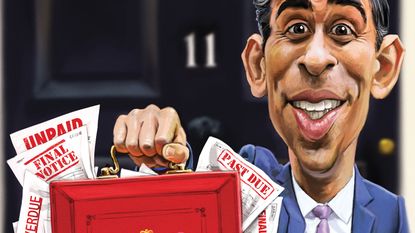Rishi Sunak’s recovery budget may look good but it is based on stealthy tax rises
The chancellor outlined his vision of the post-Covid-19 economy this week. Merryn Somerset Webb and John Stepek look at what it means for your money.


Rishi Sunak has had an exciting first year in the role of chancellor of the exchequer. He spent most of 2020 figuring out ways to keep the UK economy afloat while various levels of lockdown came and went. On Wednesday, we got some insight into how he plans to shore up both the recovery and the public finances. So what were the biggest moves?
The government has spent a lot of money in the past year to offset the impact of Covid-19 lockdowns. That’s set to continue until at least the end of September. Sunak announced the extension of the furlough and self-employment relief schemes, VAT cuts, stamp-duty holidays (see below), business-rates relief, universal credit top-ups and various other measures, all of which added another £65bn to spending for the 2021-2022 tax year. That leaves us with overall borrowing for 2021-2022 at an estimated £234bn, according to the Office for Budget Responsibility (OBR), the independent fiscal watchdog – a far cry from the £164bn forecast in November.
The good news is that the economy is expected to rebound strongly this year and next, growing by 4% in 2021 and more than 7% in 2022. But even with a solid rebound, we’re going to be left sitting on a deficit (annual overspend) of 10.3% of GDP, a drop from 17% for 2020-2021, the current tax year, but still a lot higher than anyone would have deemed sustainable in the pre-Covid-19 era. And the national debt will eclipse 100% of GDP until at least the mid-2020s.
Subscribe to MoneyWeek
Subscribe to MoneyWeek today and get your first six magazine issues absolutely FREE

Sign up to Money Morning
Don't miss the latest investment and personal finances news, market analysis, plus money-saving tips with our free twice-daily newsletter
Don't miss the latest investment and personal finances news, market analysis, plus money-saving tips with our free twice-daily newsletter
A U-turn on corporation tax
So what is Rishi Sunak planning to do about it? There are two main measures. Fiscal drag is the big one that will hit individuals in their pockets – see below for more on that. The other big move is on corporation tax. Under George Osborne, the Conservative plan was to make sure that corporation tax was always a good bit lower than in most other big economies. Sunak has entirely rejected that idea. Using the excuse that businesses have been helped out, and so they can be expected to pay the money back (conveniently ignoring who mandated that they be shut down in the first place), Sunak has raised the corporation tax rate from the current 19% to 25% from April 2023.
That’s more aggressive than had been expected, though it does come with a fair few exclusions. Small businesses (those with profits of below £50,000) will still pay a 19% rate, and only businesses with profits above £250,000 will pay the full 25%. Still, you could be forgiven for asking why, at a time when being more competitive is a priority for a post-Brexit Britain, the chancellor has hiked corporation tax quite so much.
Part of the answer came in the form of a significant carrot for businesses – the “super deduction”. Companies spending money on new plant and machinery in the next two years will be able to claim a 130% deduction in their tax bills. In effect, companies are being subsidised by taxpayers to splash out on new equipment. As Richard Godmon of accountancy group Menzies puts it: “This equates to a significant cash windfall for businesses and will help to bolster cash flow at a critical time”. Whether 130% is too generous or not (surely 100% would have done the job?) and whether – as a result – much of that investment will be productive or wasteful, is another question, but the chancellor may not care. Any short-term sugar rush of spending that results in higher GDP growth and even a bit of inflation is likely to be welcomed by the government regardless of the long-term impact.
In effect, what’s happened here, as Paul Dales of Capital Economics points out, is that Sunak has provided more “near-term support” for the economy than was expected, but overall he’s hoping to get the public finances back into some sort of order more quickly than anticipated with higher taxes from 2023-2024. The good news is that if the economy recovers faster than the OBR’s current gloomy forecasts expect, then maybe this is it for tax hikes.
As for the fact that we’ll be sitting on national debt of 100% of GDP for some time, this probably only matters if we’re an outlier. As long as the rest of the world is splashing out (the US certainly is) or struggling with growth, then the UK is unlikely to attract the specific attention of the “bond vigilantes” (to push gilt yields up sharply), or, for that matter, the “forex vigilantes” (to trigger a run on the pound). Before that happens, the chancellor will be hoping that inflation (note that index-linked gilts are set to remain low as a proportion of UK debt issuance) and the brutal but subtle action of fiscal drag will do much of the tidying-up job for him.
Propping up property...
Anyone invested in UK house prices rising for some time to come will have enjoyed the budget. The combination of spare cash (the majority of Brits have been saving more than normal), pent-up demand and last year’s stamp-duty suspension have been driving a sharp rise in both transactions and prices. The latter are now at record levels (again) with the average number of days it takes to sell a property down from 67 in November 2019 to a mere 49 in November 2020.
The chancellor is clearly keen to keep this going. The stamp-duty suspension on property sales up to a price of £500,000 had been supposed to run only until the end of March. However it will now move to the end of June – very nice indeed for the many people who have not yet completed on deals agreed months ago. Anyone buying at £600,000 in England will now find themselves paying a mere £5,000 in stamp duty, compared with what would have been £20,000 pre- Covid-19 and, according to the chancellor, 90% of buyers will pay no stamp duty at all under his scheme. But even on 30 June things won’t go back to normal: instead, the nil-rate band (which used to be £125,000) will be £250,000 until the end of September.
... with another scheme to bolster housing demand
However the stamp-duty news turned out to be just the beginning of Sunak’s plans to support the property market. For those who can’t produce enough of a house deposit to secure a mortgage he has come up with yet another taxpayer-sponsored support scheme. In a “new policy to stand behind home buyers”, for any would-be buyer (first-time or not) who can produce a 5% deposit the government will guarantee the remaining 95% of the loan with a participating lender.
So far these include Lloyds, NatWest, Santander, Barclays and HSBC. But given that the scheme is effectively a free-money scheme for the banks (the most they can lose on any one deal is 5%), expect all other banks to be participating before the week is up. We are not convinced we approve of this scheme . It will help more people buy in the short term. But in pushing prices up again (which it will) it also leaves them both with huge mortgages to service at a time when rates are more likely to rise than fall and with a nasty risk of finding themselves in negative equity should house prices ever revert to their mean relative to earnings. Still, the plan is unambiguously positive for housebuilders. Persimmon rose by 5% on Wednesday morning and Barratt, Taylor Wimpey and Berkeley were all up by 3%.
Guess who’s paying the bill
Anyone concerned about their tax bill going up in the near future can now take a deep breath. It won’t – or it won’t look like it is anyway. The chancellor confirmed on Wednesday that personal allowances for income tax will be raised in line with the Consumer Price Index next year to £12,570 and £50,270 and then stay there until 2026. Assuming wages rise in line with inflation this should mean that around 800,000 more people end up moving into the lower tax bracket and roughly the same number move into the higher-rate bracket.
The problem here is fiscal drag. There have been no headline rises, but as inflation climbs and thresholds do not, the share of your real income that goes to the Treasury will rise anyway. You might not mind this; perhaps you feel that we are all in this together. But a stealth rise in taxes is still a rise in taxes. Overall ,says Nigel Hatt, pensions specialist at Tilney, those earning between £60,000 and £100,000 will end up paying £680 more in tax over the four-year period beginning in 2021-2022 than they would have if allowances had continued to rise with consumer price inflation (CPI) – assuming CPI remains at 0.5%.
At the same time the thresholds for capital gains tax (CGT), inheritance tax and the pensions lifetime allowance (LTA) – which sets the amount that can be held in a tax-efficient pension wrapper – are also to be frozen. The latter is to stay at its 2020-2021 level of £1,073,100 until 2026. That is not generous. As Steven Cameron of Aegon notes, it is an amount that would typically buy an income for life for someone aged 65 of around £26,100 a year (inflation-linked and before tax). After tax that brings you to an income of £1,740 a month. It is not lap-of-luxury stuff.
This might also offer something of a shock to public-sector workers. Under the different (and outrageously generous) LTA calculations for defined-benefit pensions, they are currently able to receive a pension of £53,655 a year before hitting a level where they have to pay a surcharge. That sounds like a lot to most people, but as Cameron says “it would be interesting to see any analysis the chancellor has done over how many doctors or head teachers may be hit by this charge”.
Of more concern might be the freezing of the CGT allowance. There had been talk of the rate of CGT rising so many may feel they have had a reprieve. But a rise in the rate might at least have been accompanied by inflation indexing. Today no consideration is given to how long you have owned an asset when you sell it, and hence how much of its rise in value is real and how much is just generalised inflation. That can make CGT more of a tax on wealth than on gains.
All of the tax-raising measures here appear small and reasonable. But it’s worth looking at what they add up to. As Capital Economics’ Paul Dales points out, add the corporation-tax rise and it’s clear these tax hikes “do most of the work” in bringing public sector net borrowing down from 10.3% of our GDP next year to 3.9% in 2025-2026.
John is the executive editor of MoneyWeek and writes our daily investment email, Money Morning. John graduated from Strathclyde University with a degree in psychology in 1996 and has always been fascinated by the gap between the way the market works in theory and the way it works in practice, and by how our deep-rooted instincts work against our best interests as investors.
He started out in journalism by writing articles about the specific business challenges facing family firms. In 2003, he took a job on the finance desk of Teletext, where he spent two years covering the markets and breaking financial news. John joined MoneyWeek in 2005.
His work has been published in Families in Business, Shares magazine, Spear's Magazine, The Sunday Times, and The Spectator among others. He has also appeared as an expert commentator on BBC Radio 4's Today programme, BBC Radio Scotland, Newsnight, Daily Politics and Bloomberg. His first book, on contrarian investing, The Sceptical Investor, was released in March 2019. You can follow John on Twitter at @john_stepek.
-
 Barclays warns of significant rise in social media investment scams
Barclays warns of significant rise in social media investment scamsInvestment scam victims are losing an average £14k, with 61% of those falling for one over social media. Here's how to spot one and keep your money safe
By Oojal Dhanjal Published
-
 Over a thousand savings accounts now offer inflation-busting rates – how long will they stick around?
Over a thousand savings accounts now offer inflation-busting rates – how long will they stick around?The rate of UK inflation slowed again in March, boosting the opportunity for savers to earn real returns on cash in the bank. But you will need to act fast to secure the best deals.
By Katie Williams Published
-
 Should your business invest in a VoIP phone service?
Should your business invest in a VoIP phone service?Here's what you need to know about VOIP (voice over IP) services before landlines go digital in 2025.
By David Prosser Published
-
 The end of China’s boom
The end of China’s boomLike the US, China too got fat on fake money. Now, China's doom is not far away.
By Bill Bonner Published
-
 What is the future of Royal Mail in the UK?
What is the future of Royal Mail in the UK?With fewer of us sending letters and parcels, the Royal Mail is finding dealing with the nation’s post is an increasingly unprofitable and costly business.
By Simon Wilson Published
-
 What's the secret of Manolo Blahnik's success?
What's the secret of Manolo Blahnik's success?Fashion maestro Manolo Blahnik shows little sign of slowing down at 81, and his company notched up a record financial year in 2022. What is the secret of his success?
By Jane Lewis Published
-
 Michelle Mone's "tough year of pain"
Michelle Mone's "tough year of pain"Michelle Mone liked to portray herself as a working-class heroine who worked her way to the top through grit and determination. But her pedestal is built on sand.
By Jane Lewis Published
-
 Trevor Milton, the Elon Musk wannabe, is jailed for fraud
Trevor Milton, the Elon Musk wannabe, is jailed for fraudThe former CEO of Nikola, Trevor Milton, has been found guilty of lying about the development of the company's electric trucks.
By Jane Lewis Published
-
 Directors should think twice before waiving limited liability
Directors should think twice before waiving limited liabilityShould small-business directors ever provide a personal guarantee in return for bank finance?
By David Prosser Published
-
 Why Russia's economy is doing better than predicted
Why Russia's economy is doing better than predictedSanctions were supposed to strangle Russia’s economy, but it seems to be thriving. What’s going on?
By Simon Wilson Published